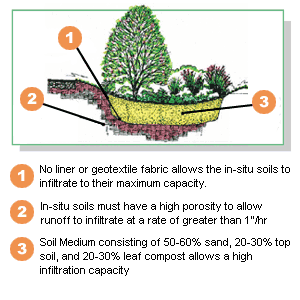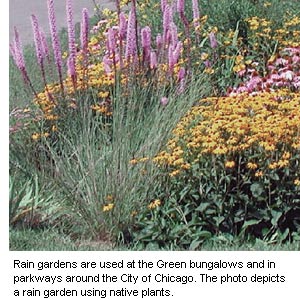Bioinfiltration: Rain Gardens
|
|
Bioinfiltration systems are shallow, landscaped depressions used to promote absorption and infiltration of stormwater runoff. This management practice is very effective at removing pollutants and reducing the volume of runoff, especially when used for parking lot islands. Stormwater flows into the bioinfiltration area, ponds on the surface, and gradually infiltrates into the soil bed. Filtered runoff is infiltrated into the surrounding soils via an absorption basin or trench. Excess water can be collected by an under-drain system and discharged to the storm sewer system or directly into receiving waters. Bioinfiltration systems typically are designed to store and treat runoff from relatively small storms, such as those that occur every year or every other year. Bioinfiltration systems should be located at least 10 feet away from buildings to ensure water does not drain into the foundations. Ideally, pretreatment should be provided to remove suspended solids from the runoff before it enters the system.
A rain garden is a simple form of bioinfiltration that typically relies on the underlying soils for drainage. Therefore it may not function properly if underlying soil is compacted by heavy equipment and/or its absorption rate is slow. Where appropriate, however, rain gardens can be fitted with French drains, or other types of underdrains, to move more water through the soil. |
Rain gardens can be aesthetically pleasing. The plants provide food and shelter for many birds, butterflies, and beneficial insects, such as dragonflies, which eat mosquitoes. Plants can include a combination of shrubs, grasses and flowering perennials where the soil medium is between 6 and 8 inches deep. Ideally, plants should consist of native wetland and prairie grasses, and wildflowers. Suggested designs incorporate perennial flowers in the spring and summer, and vividly colored or patterned shrubs and grasses in the fall and winter. Some suggested plants for rain gardens include: Black-eyed Susan, Butterflyweed, Golden Alexander, Obedient Plant, Purple Coneflower, Spiderwort, Wild Columbine and Wild Geranium. (See the resource section at the end of this guide for additional information on creating rain gardens).
|
Applicability
Maintenance Considerations |
|
If a practice fails due to clogging, rehabilitative maintenance will restore it to proper operation. Incorporating pretreatment helps to reduce the maintenance burden of bioinfiltration and reduces the likelihood that the soil bed will clog over time. Rain garden maintenance is similar to that for a typical garden - including weeding and reestablishing plants as necessary. Periodically removing sediment may be required to ensure the proper functioning of these systems. It is best for runoff to be pretreated via swales and/or filter strips before entering the rain garden to avoid sediment accumulation. Plants should be selected to reduce maintenance needs and to tolerate snow storage and winter salt and sand, where appropriate.
Cost Considerations
Bioinfiltration costs can range between $10 to $40 per square foot, based on the need for plants, control structures, curbing, storm drains and underdrains. Bioinfiltration should reduce the size and cost of necessary downstream conveyance and storage devices. Bioinfiltration may need to be replaced periodically due to sediment accumulation. The costs of rain gardens will vary depending on how much work is completed by the owner and the types of plants desired. Rain garden installations average $3 to $4 per square foot depending on soil condition and density and types of plants used. If planned and designed properly, a rain garden is likely to retain its effectiveness for over 20 years.
A rain garden is not a pond. It should not provide a breeding ground for mosquitoes. Mosquitoes need at least four days of standing water to develop as larva. Rain gardens generally should be designed to drain within six hours (water may pond for longer times during winter and early spring).


